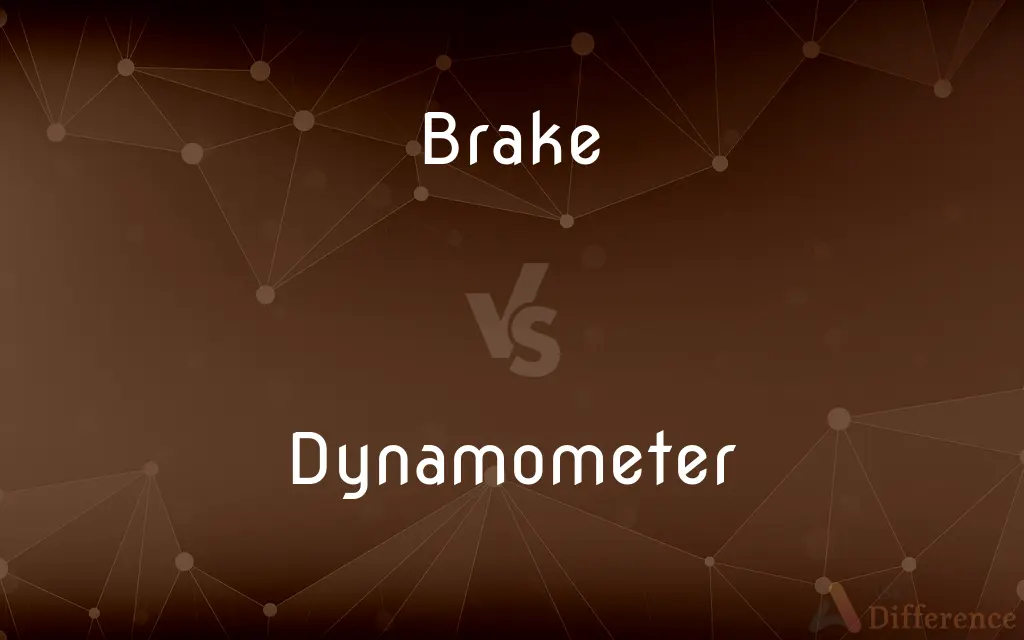Brake vs. Dynamometer — What's the Difference?
By Tayyaba Rehman & Fiza Rafique — Updated on April 23, 2024
Brake is a device used to slow down or stop a vehicle, mainly by friction; whereas, a dynamometer measures torque and power output of an engine.

Difference Between Brake and Dynamometer
Table of Contents
ADVERTISEMENT
Key Differences
Brake systems are critical in vehicles for safety, utilizing friction between brake pads and a rotating surface to decelerate or halt motion. On the other hand, a dynamometer is a diagnostic tool used primarily in engineering to measure the force, torque, or power output of an engine or other rotating machinery.
Brakes operate through mechanical, hydraulic, or electromagnetic means to apply pressure to the vehicle’s wheels. In contrast, dynamometers simulate operating conditions to measure the performance of an engine or motor without it doing actual work.
The primary function of a brake is safety-oriented, ensuring that vehicles can stop within a safe distance. Whereas dynamometers are used to gather data about a machine’s performance, often for the purpose of optimization or compliance with regulatory standards.
Brake systems are integrated components of vehicles and machinery requiring regular maintenance to ensure effectiveness and safety. Dynamometers, however, are specialized equipment found in testing and research environments, used intermittently to assess performance.
Brakes directly interact with a vehicle's wheel system, and their effectiveness can be immediately felt by the operator. Dynamometers, however, provide readings and data that require interpretation by trained professionals to influence decisions on machinery performance and development.
ADVERTISEMENT
Comparison Chart
Primary Use
Decelerating or stopping vehicles
Measuring engine or motor performance
Operating Principle
Utilizes friction between components
Measures force, torque, and power without load
Environment
Installed in vehicles and machinery
Used in testing facilities and research labs
User Interaction
Direct through vehicle controls
Indirect, requires professionals for data analysis
Maintenance Needs
Regular maintenance for safety
Intermittent use, maintenance focused on accuracy
Compare with Definitions
Brake
A device used to slow or stop a vehicle by friction.
He pressed the brake pedal to stop at the red light.
Dynamometer
A device for measuring force, torque, or power.
The engineers used a dynamometer to test the engine's output.
Brake
Mechanism to halt or control the motion of a machine.
The emergency brake is used to keep the machine from moving while repairs are made.
Dynamometer
Instrument for comparing power outputs of different engines.
The dynamometer showed variations in power among the engines tested.
Brake
Any device for slowing down machinery by absorbing energy.
The conveyor belt has a brake to regulate the speed of the materials.
Dynamometer
Used in health to measure muscle strength.
The physical therapist used a hand-held dynamometer to assess grip strength.
Brake
Act of braking as in to slow down or stop.
She hit the brake when she saw a deer jump onto the road.
Dynamometer
Equipment for testing endurance and efficiency of machines.
The factory uses a dynamometer to ensure their machines meet energy standards.
Brake
In climbing, a device to control the descent on a rope.
The climber used a brake to manage his speed on the steep descent.
Dynamometer
Tool in automotive development for performance testing.
They hooked up the car to a dynamometer to simulate road conditions.
Brake
A brake is a mechanical device that inhibits motion by absorbing energy from a moving system. It is used for slowing or stopping a moving vehicle, wheel, axle, or to prevent its motion, most often accomplished by means of friction.
Dynamometer
A dynamometer or "dyno" for short, is a device for simultaneously measuring the torque and rotational speed (RPM) of an engine, motor or other rotating prime mover so that its instantaneous power may be calculated, and usually displayed by the dynamometer itself as kW or bhp. In addition to being used to determine the torque or power characteristics of a machine under test, dynamometers are employed in a number of other roles.
Brake
A device for slowing or stopping a moving vehicle, typically by applying pressure to the wheels
He slammed on his brakes
A brake pedal
Dynamometer
Any of several instruments used to measure mechanical power.
Brake
Another term for brake van
Dynamometer
Any of various devices used to measure mechanical power, force, or torque.
Brake
An open horse-drawn carriage with four wheels.
Dynamometer
An apparatus for measuring force or power; especially, muscular effort of men or animals, or the power developed by a motor, or that required to operate machinery.
Brake
A toothed instrument used for crushing flax and hemp.
Dynamometer
Measuring instrument designed to measure power
Brake
A thicket.
Brake
A coarse fern of warm and tropical countries, frequently having the fronds divided into long linear segments.
Brake
Make a moving vehicle slow down or stop by using a brake
She had to brake hard to avoid a milk float
Brake
A device for slowing or stopping motion, as of a vehicle, especially by contact friction.
Brake
Something that slows or stops action.
Brake
A toothed device for crushing and beating flax or hemp.
Brake
A heavy harrow for breaking clods of earth.
Brake
An apparatus for kneading large amounts of dough.
Brake
A machine for bending and folding sheet metal.
Brake
A lever or handle on a machine such as a pump.
Brake
Any of various ferns of the genus Pteris having pinnately compound leaves and including several popular houseplants.
Brake
Any of certain other ferns, such as bracken.
Brake
An area overgrown with dense brushwood, briers, and undergrowth; a thicket.
Brake
A high horse-drawn carriage with four wheels.
Brake
To reduce the speed of with or as if with a brake.
Brake
To operate or apply a brake.
Brake
To be slowed or stopped by or as if by the operation of a brake.
Brake
To crush (flax or hemp) in a toothed device.
Brake
To break up (clods of earth) with a harrow.
Brake
A past tense of break.
Brake
A device used to slow or stop the motion of a wheel, or of a vehicle, usually by friction (although other resistive forces, such as electromagnetic fields or aerodynamic drag, can also be used); also, the controls or apparatus used to engage such a mechanism such as the pedal in a car.
Brake
The act of braking, of using a brake to slow down a machine or vehicle
Brake
(engineering) An apparatus for testing the power of a steam engine or other motor by weighing the amount of friction that the motor will overcome; a friction brake.
Brake
(figuratively) Something used to retard or stop some action, process etc.
Brake
(military) An ancient engine of war analogous to the crossbow and ballista.
Brake
(obsolete) The winch of a crossbow.
Brake
The handle of a pump.
Brake
A baker's kneading trough.
Brake
A device used to confine or prevent the motion of an animal.
Brake
A frame for confining a refractory horse while the smith is shoeing him.
Brake
An enclosure to restrain cattle, horses, etc.
Brake
A cart or carriage without a body, used in breaking in horses.W
Brake
A carriage for transporting shooting parties and their equipment.W
Brake
That part of a carriage, as of a movable battery, or engine, which enables it to turn.
Brake
A fern; bracken (Pteridium).
Brake
Any fern in the genus Pteris
Brake
A thicket, or an area overgrown with briers etc.
Brake
A tool used for breaking flax or hemp.
Brake
A type of machine for bending sheet metal. (See wikipedia.)
Brake
A large, heavy harrow for breaking clods after ploughing; a drag.
Brake
(obsolete) A cage.
Brake
A type of torture instrument.
Brake
(intransitive) To operate (a) brake(s).
Brake
(intransitive) To be stopped or slowed (as if) by braking.
Brake
(transitive) To bruise and crush; to knead
The farmer's son brakes the flax while mother brakes the bread dough
Brake
(transitive) To pulverise with a harrow
Brake
(archaic) break
Brake
A fern of the genus Pteris, esp. the Pteris aquilina, common in almost all countries. It has solitary stems dividing into three principal branches. Less properly: Any fern.
Brake
A thicket; a place overgrown with shrubs and brambles, with undergrowth and ferns, or with canes.
Rounds rising hillocks, brakes obscure and rough,To shelter thee from tempest and from rain.
He stayed not for brake, and he stopped not for stone.
Brake
An instrument or machine to break or bruise the woody part of flax or hemp so that it may be separated from the fiber.
Brake
An extended handle by means of which a number of men can unite in working a pump, as in a fire engine.
Brake
A baker's kneading though.
Brake
A sharp bit or snaffle.
Pampered jades . . . which need nor break nor bit.
Brake
A frame for confining a refractory horse while the smith is shoeing him; also, an inclosure to restrain cattle, horses, etc.
A horse . . . which Philip had bought . . . and because of his fierceness kept him within a brake of iron bars.
Brake
That part of a carriage, as of a movable battery, or engine, which enables it to turn.
Brake
An ancient engine of war analogous to the crossbow and ballista.
Brake
A large, heavy harrow for breaking clods after plowing; a drag.
Brake
A piece of mechanism for retarding or stopping motion by friction, as of a carriage or railway car, by the pressure of rubbers against the wheels, or of clogs or ratchets against the track or roadway, or of a pivoted lever against a wheel or drum in a machine.
Brake
An apparatus for testing the power of a steam engine, or other motor, by weighing the amount of friction that the motor will overcome; a friction brake.
Brake
A cart or carriage without a body, used in breaking in horses.
Brake
An ancient instrument of torture.
Brake
A restraint used to slow or stop a vehicle
Brake
Any of various ferns of the genus Pteris having pinnately compound leaves and including several popular houseplants
Brake
Large coarse fern often several feet high; essentially weed ferns; cosmopolitan
Brake
An area thickly overgrown usually with one kind of plant
Brake
Stop travelling by applying a brake;
We had to brake suddenly when a chicken crossed the road
Brake
Cause to stop by applying the brakes;
Brake the car before you go into a curve
Common Curiosities
Can a dynamometer be used for vehicles?
Yes, dynamometers are extensively used to test and measure the performance of vehicle engines.
What type of maintenance do brakes require?
Brakes require regular checks for wear and tear, brake fluid replacement, and pad replacements to ensure optimal performance and safety.
What is the main purpose of a brake?
The main purpose of a brake is to slow down or stop a vehicle or machinery.
How does a dynamometer function?
A dynamometer functions by measuring the torque and power output of an engine or motor, simulating its performance in a controlled environment.
Where are brakes typically used?
Brakes are typically used in vehicles like cars, motorcycles, bicycles, and heavy machinery.
What are the safety implications of brake failure?
Brake failure can lead to accidents due to the inability to stop or control a vehicle, highlighting the importance of regular maintenance.
How do professionals use data from a dynamometer?
Professionals use data from a dynamometer to optimize engine performance, ensure regulatory compliance, and design new engines.
What is the cost of maintaining a dynamometer?
The cost can vary widely depending on the type and usage, but maintenance generally involves calibration and component checks to ensure accuracy.
Is a dynamometer usage common in everyday vehicles?
No, dynamometer usage is not common in everyday vehicles; it is more frequently used in research, development, and testing environments.
What distinguishes a brake from a dynamometer?
A brake is a safety device meant to stop or slow down vehicles, while a dynamometer is a measurement tool used primarily in testing and research.
Can brakes be tested using a dynamometer?
Yes, vehicle brakes can be tested under simulated conditions using certain types of dynamometers to assess their response and effectiveness.
How does a dynamometer contribute to environmental regulations?
Dynamometers help in assessing engine emissions and efficiency, thereby aiding compliance with environmental regulations.
What happens if a dynamometer gives incorrect readings?
Incorrect readings can lead to misguided assessments, potentially leading to engine designs that do not meet performance or safety standards.
Are there different types of brakes?
Yes, there are various types of brakes including disc brakes, drum brakes, and regenerative brakes among others.
How accurate are dynamometers?
Dynamometers are highly accurate, designed to provide precise measurements of torque, power, and force.
Share Your Discovery

Previous Comparison
Millet vs. Teff
Next Comparison
Revelling vs. RevelingAuthor Spotlight
Written by
Tayyaba RehmanTayyaba Rehman is a distinguished writer, currently serving as a primary contributor to askdifference.com. As a researcher in semantics and etymology, Tayyaba's passion for the complexity of languages and their distinctions has found a perfect home on the platform. Tayyaba delves into the intricacies of language, distinguishing between commonly confused words and phrases, thereby providing clarity for readers worldwide.
Co-written by
Fiza RafiqueFiza Rafique is a skilled content writer at AskDifference.com, where she meticulously refines and enhances written pieces. Drawing from her vast editorial expertise, Fiza ensures clarity, accuracy, and precision in every article. Passionate about language, she continually seeks to elevate the quality of content for readers worldwide.














































